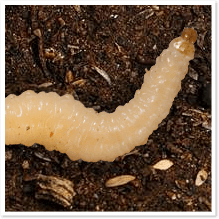 Historical estimates suggest northern corn rootworm and western corn rootworm are responsible for nearly $1 billion dollars annually in crop losses and control costs. Corn rootworm eggs overwinter in the soil and begin to hatch and feed on corn roots in late May or early June.
Historical estimates suggest northern corn rootworm and western corn rootworm are responsible for nearly $1 billion dollars annually in crop losses and control costs. Corn rootworm eggs overwinter in the soil and begin to hatch and feed on corn roots in late May or early June.
Larval feeding can decrease yield potential and increase the risk of root lodging. Larvae feed on roots for approximately three weeks, which is the time it takes to reach pupation. Adult emergence begins in early July with peak emergence occurring around the beginning of August. Adult beetles feed on corn leaves, pollen, and soft kernels, but cause the most damage when feeding on silks.
Crop rotation may not be as effective. Traditionally, crop rotation has been an effective method for preventing larval root damage. However, in certain areas of the Corn Belt, rotation is no longer as effective due to extended diapause populations of NCRW and the soybean variant of WCRW. The eggs of the extended diapause biotypes of NCRW require two or more winters to develop and hatch making a corn/soybean rotation less effective as a management tool. In addition, the soybean variant biotype of the female adult WCRW migrates to soybean fields to lay their eggs. This ensures infestation of the next year’s corn crop, once again rendering rotation with soybeans is ineffective.
Management
Scouting is an integral part of CRW management. The extensive data sets from numerous university and on-farm trials have shown selecting a product with transgenic B.t. trait technology is the most consistent form of CRW larval control compared to conventional methods. Scouting is also an integral part of successful CRW management. Root damage ratings are a good measurement of current control methods and efficacy, but do little to help plan control strategies for successive years. Adult CRW beetle counts are a key component in assessing the potential number of eggs that may be laid in a field the following year. CRW beetle populations are dependent on the CRW emerging from within the field and also those that immigrate from other fields. Because future CRW populations and densities are independent of the performance of the B.t. trait technology or any other insect management tactics employed during the existing crop season, scouting should serve as the primary source of information used to formulate an effective control strategy for the following year. Scouting becomes increasingly important for farmers in high pressure areas that utilize practices conducive to increasing CRW populations. A few examples of production practices that may favor CRW populations include: planting continuous corn, late planted corn fields relative to others in the area, and planting late maturity hybrids such as those used for silage. Full season hybrids used by many silage farmers are often prime targets for escalating CRW beetle populations since they pollinate later in the season when other desirable adult CRW food sources have deteriorated.
Assess control strategy with root damage ratings. Since root damage cannot be seen above ground, root digs are imperative to help assess your current corn rootworm management strategy. Scouting for CRW larval damage should take place in mid-July. To do so, dig a series of corn root balls (one foot in diameter), shake off the soil, and wash roots. Root damage due to corn rootworm larval feeding consists of brown feeding scars often along the side of the roots, tunneling inside the larger roots, and root pruning with the roots eaten back toward the base of the stalk. Injury may be limited to a single root, or consist of multiple whorls of roots chewed back.
Scouting for adult corn rootworm beetles. Because adult CRW beetle counts help estimate the extent of CRW larval damage a farmer might expect the next year, Monsanto recommends field scouting for adult CRW beetles during the key months of July and August when peak CRW beetle activity occurs. Thresholds vary by state and planting density. In general, if adult beetle populations exceed ¾ – 1 beetle per plant, the potential for significant yield loss the next season may exist if no control tactics are instituted. Where secondary control tactics are required, well-timed foliar adult beetle sprays have been effective in keeping CRW populations at manageable levels when used in conjunction with B.t. CRW technology. Farmers in irrigated areas have also experienced good results with insecticides labeled for chemigation treatments against adult CRW. However, the key to success is timing the insecticide applications prior to significant egg laying activity of the female adults. Consult your local crop consultant or university extension specialist for more information.
Best Management Practices (BMP) for heavy pressure CRW.
Since its introduction, CRW B.t. trait technology has provided root and yield protection benefits against CRW on greater than 99.9% of corn acres utilizing the technology. In less than 0.1% of the acres planted, root lodging has been observed at various levels. In situations where root lodging is observed, it is generally associated with extremely heavy CRW populations, but also combined with other environmental conditions such as wet soils and wind. Therefore, emphasizing the importance of routine scouting and field monitoring of insect population densities is critical in understanding when the addition of alternate insect control tactics may be justified. In some cases this could be lay-by treatments of soil insecticides during peak hatch of CRW, chemigation treatments of approved insecticides, or adult beetle spray products designed to reduce the CRW population to manageable levels.
Sources: K.L. Steffey.1999. Handbook of Corn Insects. Entomological Society of America, Larson, E. 2006. Corn/ Wheat Planting Pitfalls. March 2006 Agronomy Notes Newsletter. Mississippi State University Extension Service. Available On-line: Ratcliffe, S.T., Gray, M.E., Steffey, K.L. 2004. Corn Rootworm Diabrotica spp. University of Illinois Extension. Integrated Pest Management. http://ipm.illinois.edu


